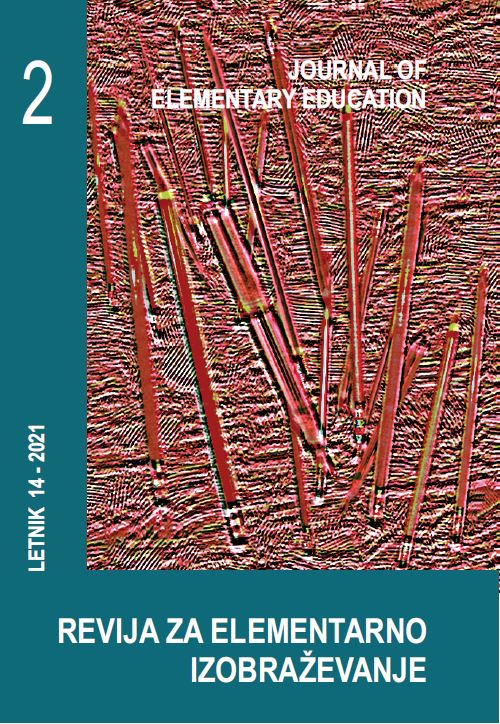Children With Reduced Cognitive Efficiency and Addition of Natural Numbers up to 20: A Case Study
Abstract
The study deals with teaching and learning the addition of natural numbers up to 20 in the first two years of primary school. The first part presents the theoretical background for addition of natural numbers, the procedural and conceptual approach to addition, and the theory of the additive triad. The causes of the difficulties some children have with the field of the addition of natural numbers are outlined, and the issue of reduced cognitive efficiency is briefly introduced as one of the causes. The second part of the study presents a case study of a girl (7 years old) who experienced difficulty in learning addition. The approaches to and results of remedial tutoring completed by the girl are described. In the discussion, the issue of the addition of natural numbers is incorporated into a broader pedagogical context.
Downloads
References
Blažková, R. (2017). Didaktika matematiky se zaměřením na specifické poruchy učení. Brno: Masarykova univerzita.
Ellemor-Collins, D., and Wright, R. (2009). Structuring Numbers 1 to 20: Developing FacileAddition and Subtraction. Mathematics Education Research Journal, 21(2), 50–75.
Feez, S. (2010). Montessori and Early Childhood. London: Sage.
Fuson, K. C. (1982). An analysis of the counting-on solution procedure in addition. In T. P. Carpenter, J. M. Moser, & T. A. Romberg (Eds.), Addition and Subtraction: A cognitive perspective (pp. 67–81). Hillsdale, NJ: Erlbaum.
Fuson, K. C., Kwon, Y. (1992). Korean children’s single-digit addition and subtraction: number structured by ten. Journal for Research in Mathematics Education, 23(2), 148–165.
Gaidoschik, M. (2015). Learning to compute without counting in first grade: A matter of patterns. Studia Scientifica Facultatis Paedagogicae Universitas Catholica Ružomberok, 14(2), 12–21.
Geary, D. C., and Hoard, M. K. (2005). Learning disabilities in arithmetic and mathematics: Theoretical and empirical perspectives. In J. I. D. Campbell (Ed.), Handbook of Mathematical Cognition (pp. 253–267). New York: Psychology Press.
Gray, E. and Tall, D. (1994). Duality, ambiguity and flexibility: A proceptual view of simple arithmetic. Journal for Research in Mathematics Education, 26(2), 115–141.
Groen, G. J., and Parkman, J. M. (1972). A chronometric analysis of simple addition. Psychological Review, 79, 329–343.
Hejný, M. (2014). Vyučování matematice orientované na budování schémat: aritmetika 1. stupně. Praha: Univerzita Karlova, Pedagogická fakulta.
Hiebert, J., and Lefevre, P. (1986). Conceptual and procedural knowledge in mathematics: An introductory analysis. In James Hiebert (Ed.), Conceptual and Procedural Knowledge: The case of mathematics (pp. 1–27). Hillsdale, NJ: Erlbaum.
Hoffman B., Schraw G., and McCrudden M. T. (2012) Cognitive Efficiency. In Seel N. M. (Ed.), Encyclopedia of the Sciences of Learning. Boston: Springer.
Hruša, K. et al. (1962). Metodika počtů pro pedagogické instituty 2. Praha: SPN.
Janík., T., Slavík, J., Najvar, P., Janíková, M., and Rusek, M. (2019). 3A Content-Focused Approach for Improving Instruction: Developing and Sharing Knowledge in Professional Communities. In T. Janík, M. I. Dalehefte, and S. Zehetmeier (Eds.), Supporting Teachers: Improving Instruction: Examples of Research-based Teacher Education (pp. 55–76). Münster/New York: Waxmann.
Jonnson, B., Norqvist, M., Liljekvist, Y., and Lithner, J. (2014). Learning mathematics through algorithmic and creative reasoning. Journal of Mathematical Behavior 36, 20–32.
Kahneman, D. (1973). Attention and Effort. Englewood Cliffs: Prentice-Hall.
Lukesch, H. (2001). Psychologie des Lernens und Lehrens. Regensburg: S. Roderer Verlag.
Mareš, J. (2015). Tvorba případových studií pro výzkumné účely. Pedagogika, 65(2), 113–142.
Murata, A., and Fuson, K. (2001). Learning paths to 5- and 10-structured understanding of quantity: Addition and subtraction solution strategies of Japanese children. In R. Speiser, C. S. Maher, and C. Walter (Eds.), Proceedings of the Twenty-Third Annual Meeting of the North American Chapter of the International Group for the Psychology of Mathematics Education, Vol. 2 (pp. 639–646). Columbus, OH: ERIC Clearinghouse for Science, Mathematics, and Environmental Education.
Nolen-Hoeksema, S., Fredrickson, B. L., Loftus, G. R., and Wagenaar, W. A. (2012). Psychologie Atkinsonové a Hilgarda. Praha: Portál.
Research Institute of Education in Prague (2007). Framework Educational Programme for Elementary Education. Retrieved from: http://www.nuv.cz/file/195 (Accessed April 29th, 2021).
Sharma, M. C. (2015). Numbersense: a window into dyscalculia and other mathematics difficulties. In Chinn, S. et al. The Routledge International Handbook of Dyscalculia and Mathematical Learning Difficulties. Routledge.
Slavík, J., Stará, J., Uličná, K., Najvar, P. et al. (2017). Didaktické kazuistiky v oborech školního vzdělávání. Brno: Masarykova univerzita.
Copyright (c) 2021 Irena Budínová, Tomáš Janík

This work is licensed under a Creative Commons Attribution 4.0 International License.
